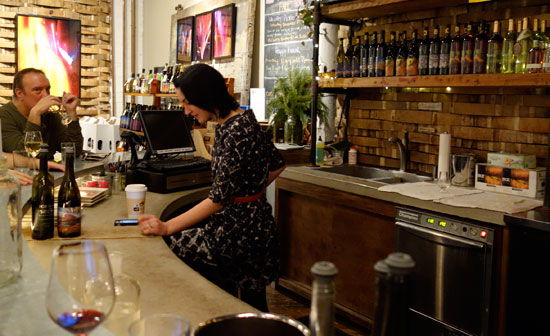Day Four • 12 Sips of Brooklyn
 HERE IN CONCRETE-LANDSCAPED NEW YORK, we tend to think of wine as a product of elsewhere; foreign lands with exotic cultures and languages, like California or France. But in the past four years, two wineries have sprung up in Brooklyn alone: Red Hook Winery (established 2008) and Brooklyn Winery (2010), committed to actual production within the borough limits. Another approach is that taken by Brooklyn Oenology, which focuses on regional grapes and produces its wines outside the city. But it has set up a tasting room in Williamsburg to help promote its production.
HERE IN CONCRETE-LANDSCAPED NEW YORK, we tend to think of wine as a product of elsewhere; foreign lands with exotic cultures and languages, like California or France. But in the past four years, two wineries have sprung up in Brooklyn alone: Red Hook Winery (established 2008) and Brooklyn Winery (2010), committed to actual production within the borough limits. Another approach is that taken by Brooklyn Oenology, which focuses on regional grapes and produces its wines outside the city. But it has set up a tasting room in Williamsburg to help promote its production.
Wine has a long history of being made in one place and consumed in another—remember all those ancient amphorae dredged up from the bottom of the Mediterranean? But local production has its merits. It is one of those tropes of the wine culture that to be in the know, one has to taste those wines that “never get shipped outside the little town in [insert name of region here] where they are made,” with the implication that the locals snare the best for themselves, leaving the rest of us to sip the leavings from the barrels. As well, in our increasingly environmentally aware culture, many question whether it is a good idea to be shipping quite so many goods, including wine bottles, thousands of miles, burning fossil fuels and polluting the planet.
When the French use the term terroir to refer to the effect of a geographical region on its agricultural products, they sometimes elevate that to a mythical level. But they are on to something. The number of steps in getting a wine from a little vineyard in Europe to our dinner table can appear daunting. Very different from the winemaker leaning over and drawing off a bottle for you from the barrel.
A good place to begin to sample the local terroir is the Brooklyn Oenology tasting room. They have a nice selection of wines they are making from New York State grapes. They have three reds currently, with two 2006 vintages (unlike the other Brooklyn wineries, which haven’t been around long enough to actually have wines more than a couple of years old).
- 2006 Merlot: 93% Merlot with 5% Cabernet Sauvignon and 2% Petit Verdot (all grapes from Long Island’s North Fork).
- 2008 Motley Cru: 40% Petit Verdot, 37% Cabernet Sauvignon,18% Syrah, and 5% Merlot (all North Fork grapes, as well).
- 2006 Social Club Red: a blend of 62% Merlot, 26% Cabernet Franc, 8% Cabernet Sauvignon, 3% Malbec, 2% Petit Verdot, 1% Syrah. I would categorize this last as outside the terroir as 2/3 of the grapes are from the Finger Lakes region and hence had to cross bridges to get here.
The staff at the tasting room are helpful and friendly, there is a variety of regionally sourced cheeses and charcuterie on the menu, and the facility hosts a number of events including movie nights and a happy hour on weeknights before 7 pm that offers two glasses of wine for the price of one.
We’ve talked about Brooklyn Winery elsewhere, and they have a nice selection of reds, including the 2010 North Fork Blend (81% Merlot and 19% Cabernet Franc), which we’ll be saving for our Christmas table. The winery encourages you to bring your own growler so you can enjoy that “out-of-barrel” experience directly.
The Red Hook winery was badly damaged during Sandy and is currently offering “survival packs” of their wine in an effort to rebuild. Their wines are also available at the Brooklyn Wine Exchange on Court Street.
And some time soon, perhaps some wine connoisseur will lean over his dinner table to whisper of a wine bottle he snagged “that, you know, never even gets across the BQE.”
Postscript: Noticed on an old Brooklyn Historical Society blog post that December 7 th was the anniversary of the repeal of Prohibition. That reminded me that although we now welcome the new winemakers to Brooklyn, we are probably far from the high point of Brooklyn winemaking. Many immigrant families, particularly from Italy, were used to making wines. During Prohibition, thousands of personal winemaking operations went on in the borough, taking advantage of a loophole that allowed manufacture for personal or religious consumption. The grape consumption in the borough must have been truly spectacular through the 1920s and early 1930s.
Brooklyn Oenology
209 Wythe Avenue, Williamsburg
718-599-1259
Brooklyn Winery
213 North 8th Street, Williamsburg
347-763-1506
Red Hook Winery
175 – 204 Van Dyke Street, Red Hook
347-689-2432
Brooklyn Wine Exchange
138 Court Street, Cobble Hill
718-855-9463
Photographs by Basia Hellwig. Date stamp typographic design by Joy Makon Design. The font is Cochin, by Georges Peignot, Linotype, 1912.





















You must be logged in to post a comment.